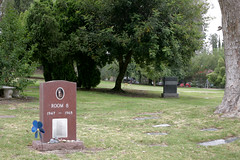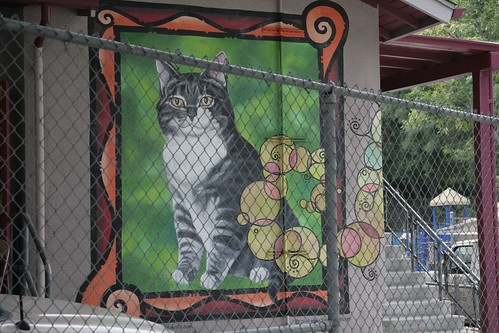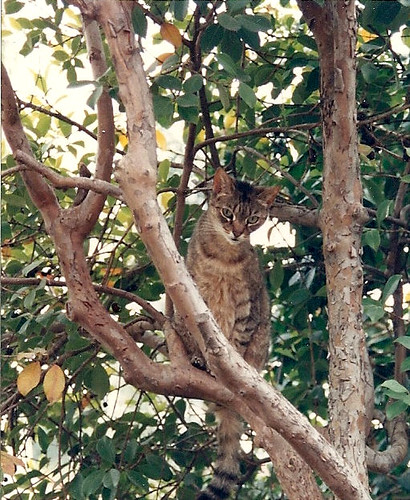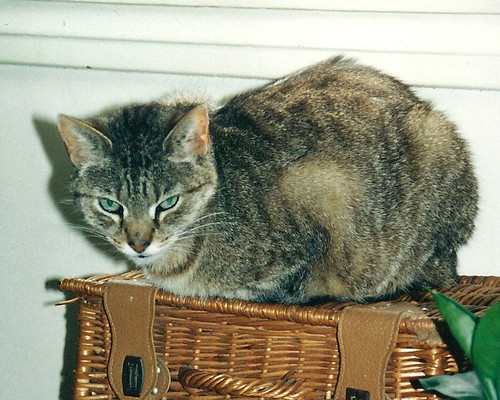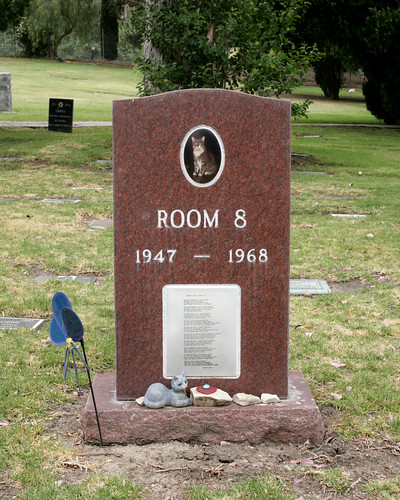
As I continued my research into Room 8's history and legacy, I discovered a few unexpected and quite delightful treasures. One these was Roger Vargo. On one of my internet searches I came across Roger's website, Explore Historic California. There, I found a first-hand account of Room 8 from someone who actually knew him as a child. His story is filled with quotes from Room 8's surviving friends and a litany of extra-curricular activities whereby Room 8 reached out into the community and the world as an example of the best of human-animal relationships. I also found the Room 8 Memorial Cat Foundation, a no-kill shelter and adoption agency for special-needs cats in Riverside, California. The Historic Echo Park website has a short article on Room 8 which features a lovely photo of one of the students and the cat being entertained by one of his guitar-playing neighbors. He even has his very own Wikipedia entry. All this for a cat who passed on over 40 years ago.
Why does a little elementary school, hidden away in Elysian Heights, still celebrate the life and the accomplishments of a simple alley cat? How did such an unassuming little animal come to be so beloved, not just in his community, but around the world? What was there about this cat that endeared him to everyone who met him or even knew about him? Perhaps it's not just a quality in Room 8 that created this phenomenon, but a quality that all of us humans possess. Certainly, Room 8 had qualities which we humans admire -- loyalty and independence, certainly, but aloofness, too, and an ability to wordlessly express affection, distain, satisfaction and love. But what human quality caused the staff of the school to break the rules and adopt a cat? What need in all of us is fulfilled by such relationship? Do we have an inherent desire to nurture the helpless, to give shelter to the homeless, to adopt the stray animal, to return the baby bird to its nest, to rescue the cat in the tree. Perhaps we do.
Perhaps humans at their best are kind, generous, helpful, happy and loving by nature. If that is the case, then someone, or some cat, who needs help would appeal to the best in human-kind. Room 8, it would seem then, became the focus of this impulse to help and, thus, brought together a school and a community, the effects of which spread across the world via the print and electronic media. Room 8 got just what he needed, a very large, loving, extended family. His worldwide family in turn received the satisfaction of seeing the object of their help and affection go on to thrive and live a long, rich life as a result of their efforts.
It is a perfect example of what can happen when people get together with a common goal to do something good, good for themselves, good for Room 8, good for their city and good for their world. When your goals move you toward survival, toward a better life for yourself, your family, and your friends, it is very easy to get lots of other people to help you. That impulse to help, to do something good, is what Room 8 brought to Elysian Park Elementary School. That impulse lives on in the memorial etched in the concrete around the school, in the classroom where Room 8's story is read to students each year, in the Room 8 Memorial Cat Foundation, in Roger Vargo's Room 8 story on his website, and in every mention of Room 8 in articles and guidebooks. That is Room 8's legacy, that is why he came to Elysian Heights Elementary School. He brought out the best in his human companions, he enriched their lives, lightened their hearts, made them laugh and, then, left them to carry on his work.
The last thing I found in my quest for the history of this extraordinary cat was his gravesite. Room 8 was buried in Los Angeles Pet Memorial Park in 1968 after he passed away at age 22. I drove out there the other day to see for myself the final resting place of this remarkable creature. His monument stands in the middle of the well-tended cemetery, under some beautiful trees in Calabasas, California. It's a bit off the beaten path, but it was well worth the trip to find the ending place of the main character in this story. As I approached the stone, a sparrow, who had perched there, flew off into one of the surrounding trees. I stood in front of the stone and thought about all that I knew of this cat and was struck by how much joy and purpose this one animal had brought into the lives of so many people. I thanked him then, turned and walked back to my car. May the memory of Room 8, and the legacy he left, never die. The world is greatly in need of you, Room 8, now more than ever. So, thank you, Room 8, you've gained another fan. Keep up the good work.
